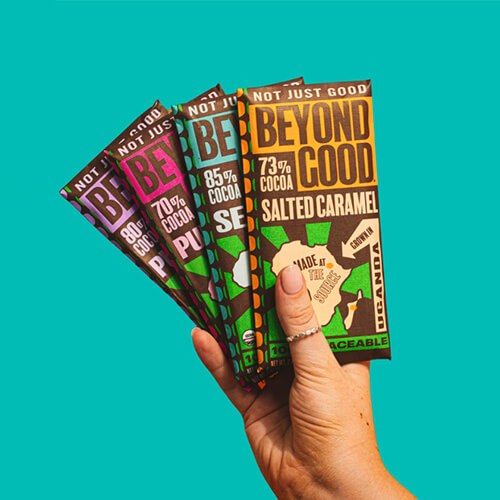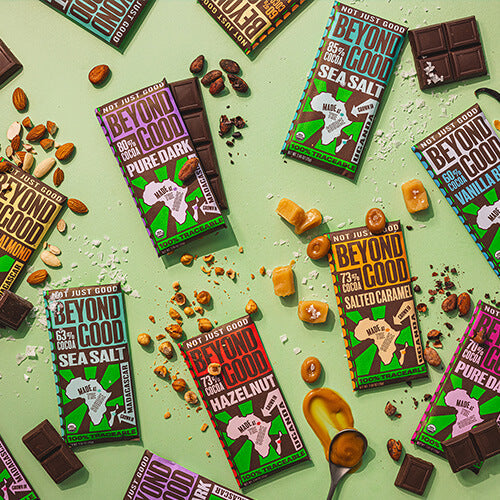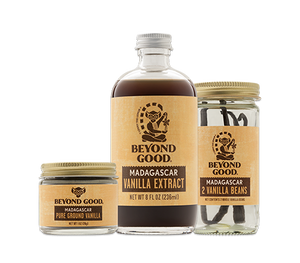Frequently Asked Questions
Single Origin chocolate means that the cocoa used to produce the chocolate all comes from one specific place, rather than a blend of cocoa beans from different origins.
Our Madagascar chocolate bars reflect the bright, fruity flavors characteristic of Madagascar cocoa, while our Uganda bars are more traditionally rich and chocolatey, with notes of vanilla and apricot.
A Single Origin chocolate bar tastes unique because of where its cocoa comes from.
Cocoa percentage refers to the amount of a chocolate bar that comes from a cocoa bean by weight. That means that both the whole cocoa beans we process and the additional cocoa butter we add for tempering and texture make up the cocoa percentage on the front of our bars.
Lower percentage bars will be a little bit lighter and sweeter, and higher percentage bars are darker with a more intense cocoa flavor.
Madagascar cocoa has bright notes of red fruit like raspberry and cherry, while Ugandan cocoa is rich and traditionally chocolatey.
Both are delicious in their own way, and we design inclusion bars to complement their unique flavor profiles.
Africa is the leading producer of agricultural raw materials like cocoa, coffee, and vanilla but these items are exported and processed in Europe or North America. By producing at source in Madagascar we’re able to add value to the local economy, create skilled jobs and produce a finished product that creates more economic activity.
The biggest issue in the chocolate industry is farmer poverty. By making chocolate at the source and working directly with farmers we’re able to pay them significantly more than the industry average.
We don’t work with middlemen that chip away at farmer profit. Making chocolate at source is a win, win, win situation. Farmers earn more, customers get a high-quality product (since we’re able to test the cocoa before purchasing it) and we’re able to keep our prices lower than other makers of premium chocolate since we don’t have to pay for the multiple levels of middlemen, exporters, and importers.
We’ll ship directly to you if you live in the lower 48 states and DC. If you live elsewhere, check out our store locator to find us at a retailer near you.
Please visit our Faire account here or write us at lenny@beyondgood.com.
At the moment we do not ship directly to any individuals or businesses that are not in the lower 48 states and DC.
All of our chocolate is made with organic cocoa beans, organic cocoa butter, and organic cane sugar.
Not all of our bars are certified organic, in part because the organic ingredients we use to make some of our inclusion bars lose their organic certification when exported to Madagascar.
Yes, we only make dark chocolate bars that do not contain dairy as an ingredient.
Because we still make some of our chocolate with a co-manufacturer that also makes milk chocolate, some of our bars state “May contain traces of milk”.
Chocolate is best stored out of sunlight at around 65 degrees Fahrenheit. We recommend storing your chocolate in a cool, dry place. In most situations, a cabinet at room temperature will work just fine.
If you’ve ever noticed white spots on the surface of your chocolate bar, it doesn’t mean that it’s gone moldy, it means that it’s bloomed. Properly tempered chocolate has been heated and cooled in a precise way to make the sugar and cocoa butter crystallize to give chocolate its shiny brown surface and clean snap.
When tempered chocolate is stored in temperatures that are too high or too low or kept in direct sunlight, it can bloom, which means that its cocoa butter or sugar loses that crystallization and makes the surface cloudy or dotted with white, and can become gritty.
Sunflower Lecithin is an emulsifier, which stabilizes the bar and creates a smoother mouth-feel. It allows us to make delicious, consistent bean-to-bar chocolate at scale and remain soy-free.
We test for the presence of heavy metals in all of our bars once per year. Our chocolate is safe. It has naturally occurring levels of cadmium and lead. These are not harmful for human consumption. All of our products are in compliance with strict quality and safety requirements of the U.S. FDA and California’s Proposition 65.
We do not think giving everyone a living income is a basic human right. Because it doesn’t consider the efforts individuals make, or how income is generated and obtained. We do believe that people should be able to live on the wages they receive for the work they do. We do believe in creating opportunity, no matter where you start.
The opportunity to earn a living income is a basic human right. Access to an environment with the potential for human growth is a basic human right. A life free from terrible things like torture and forced labor is a basic human right. Access to education. Access to work. Access to upward mobility. These are all human rights.





